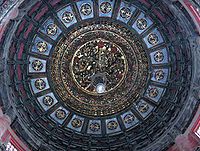This is an old revision of this page, as edited by Mattisse (talk | contribs) at 13:31, 9 October 2007 (creating article). The present address (URL) is a permanent link to this revision, which may differ significantly from the current revision.
Revision as of 13:31, 9 October 2007 by Mattisse (talk | contribs) (creating article)(diff) ← Previous revision | Latest revision (diff) | Newer revision → (diff)
The zaojing (Chinese: 藻井; pinyin: zǎojǐng) is an elaborately ornamented wooden ceiling in traditional Chinese architecture. Constructed without nails, the layered pieces of the ceiling are held together by interlocking bracket sets (dougong). The zaojing resembles an intricately carved or painted dome, coffer or cupola. The zaojing has been found in tombs of the Han Dynasty dating the use of this architectural feature back at least 2,000 years.
The zaojing is bordered by a round, square, or polygon frame with its brackets projecting inward and upward from its base. Deeply recessed panels shaped like a well (square at the base with a rounded top) are fitted into the ceiling's wooden framework. The center panel is often decorated with water lilies or other water plants. The name, zaojing, is a combination of zǎo (aquatic plants) and jǐng (well). The relationship of the name to water stems from the ancient fear that wooden buildings would be destroyed by fire and that water from the zaojing would prevent or quell the fire's flames.
Use
In traditional Chinese architecture, every facet of a building was decorated using various materials and techniques. Simple ceiling ornamentations in ordinary buildings were made of wooden strips and covered with paper. More decorative was the lattice ceiling, constructed of woven wooden strips or sorghum stems fastened to the beams. The most decorative and the most complex ceiling was the zaojing. Because of the intricacy of its ornamentation, the zaojing was reserved for the ceilings of the most important Chinese buildings such as imperial palaces and Buddhist temple altars.
The tomb of Empress Dowager Wenmind of the Northern Wei Dynasty has zaojing in the flat-topped, vaulted ceiling in the back chamber of her tomb. The Baoguo Monastery in Yuyao in Zhejiang has three zaojing in the ceiling, making it unique among surviving examples of Song architecture. Sanquing Hall (Hall of the Three Purities) is the only Yuan period structure with three zaojing in its ceiling. Zaojing are frequently found in Han Dynasty tombs.
Notes
- "Zaojing ceiling". taiwanschoolnet.org. Retrieved 2007-09-03.
{{cite web}}: Cite has empty unknown parameter:|month=(help) - ^ "Zaojing". peopledaily.com. Retrieved 2007-09-03.
{{cite web}}: Cite has empty unknown parameter:|month=(help) - "Sunken coffer ceiling". chinainfoonline.com. Retrieved 2007-09-13.
{{cite web}}: Cite has empty unknown parameter:|month=(help) - ^ Steinhardt, Nancy W. (2002). Chinese Architecture (English Ed. ed.). Yale University Press. pp. p. 8. ISBN 0-300-09559-7.
{{cite book}}:|edition=has extra text (help);|pages=has extra text (help) - Xinian, Fu (2002). Chinese Architecture -- The Three Kingdoms, Western and Eastern Jin, and Northern and Southern Dynasties (English Ed. ed.). Yale University Press. pp. p. 76. ISBN 0-300-09559-7.
{{cite book}}:|edition=has extra text (help);|pages=has extra text (help) - Daiheng, Gao (2002). Chinese Architecture -- The Lia, Song, Xi Xia, and Jin Dynasties (English Ed. ed.). Yale University Press. pp. pp 134–135. ISBN 0-300-09559-7.
{{cite book}}:|edition=has extra text (help);|pages=has extra text (help)